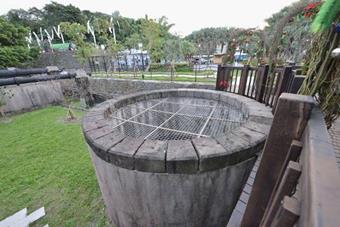喞筒井 Pumping Well

臺北水道的第一喞筒井是矩形,水源透過喞筒井,及喞筒室內喞筒機具將水送至分水井內,而淨化處理完成之清水則是經過第二喞筒井將水輸送至觀音山上淨水池。
Pumping wells normally go with pumping rooms. A pumping well is to pressurize and pump the water from the intake unit to the distribution well, then to other wells or pools. A pumping well is required when the altitude of the place where the intake unit is placed is lower; in other words, water cannot be delivered through natural gravity force. There is no fixed outlook or modeling of pumping wells; shapes like rectangular, round, and oval are very common and mainly made of either concrete or concrete with reinforcing bars. There is no fixed ratio of depth to internal diameter, either.
The 1st pumping well of the "Taipei Water Source Site" in rectangular shape. Water went through the well into the room and then was pumped by the equipment to the distribution well. The finished water then went through the 2nd pumping well and was then delivered to the water purification reservoir on Mt. Guanyin (also known as Guanyinshan nowadays).
